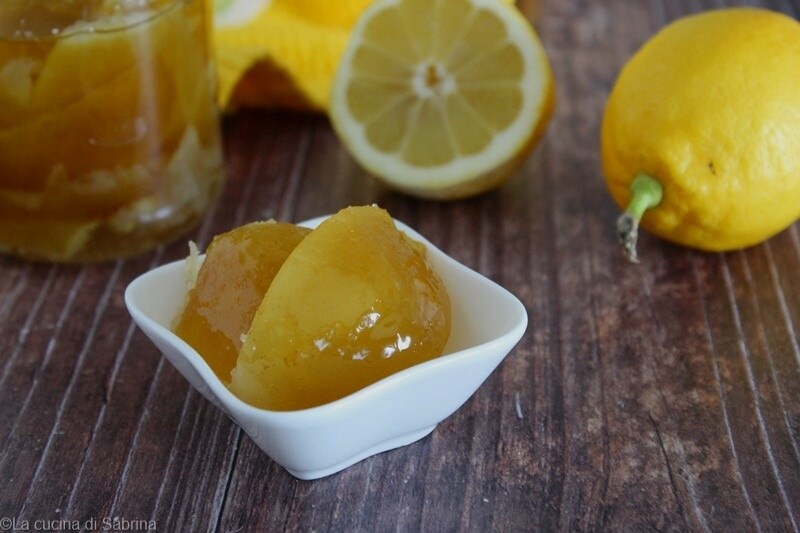How are candied lemons made?
You start with lemons that must be strictly untreated, and you need a refractometer and a bit of patience!
But then time and patience reward you with a wonderful, fragrant, soft, and extraordinary product, unlike anything found at the supermarket!
And thus we can fill our colomba cake, or the pastiera and why not, the Christmas brioche and all those sweets that require candied fruit.
So, since I was lucky enough to receive some very fragrant lemons, I bought the refractometer and made my own candied fruits! If you’re interested in discovering how to make candied lemons, read the article.
READ THE ADDITIONAL NOTES AT THE END OF THE RECIPE.
OTHER INTERESTING RECIPES:

- Difficulty: Medium
- Cost: Medium
- Rest time: 7 Days
- Preparation time: 7 Days
- Cooking methods: Boiling
- Cuisine: Italian
- Seasonality: All seasons, Christmas
- Energy 428.05 (Kcal)
- Carbohydrates 115.61 (g) of which sugars 110.49 (g)
- Proteins 0.65 (g)
- Fat 0.13 (g) of which saturated 0.02 (g)of which unsaturated 0.04 (g)
- Fibers 4.59 (g)
- Sodium 7.80 (mg)
Indicative values for a portion of 130 g processed in an automated way starting from the nutritional information available on the CREA* and FoodData Central** databases. It is not food and / or nutritional advice.
* CREATES Food and Nutrition Research Center: https://www.crea.gov.it/alimenti-e-nutrizione https://www.alimentinutrizione.it ** U.S. Department of Agriculture, Agricultural Research Service. FoodData Central, 2019. https://fdc.nal.usda.gov
Ingredients
Candied lemons
- 5 oz lemon peel (equivalent to 2/3 lemons)
- 1.5 cups sugar
- 1.5 cups water
- glucose (the amount is calculated at the end of the process)
Tools
If you don’t have a refractometer, this is the one I use.
- refractometer
How to make candied lemons:
Use untreated or organic lemons; wash well and dry.
The indicated weight of 450 g refers to the finished product, that is, the candied fruits with all the syrup.
Freeze the lemon peels for at least 12h, to soften the fibers.
– When taking the peels, it is essential to also take the white part, trying not to touch the pulp; if it happens, remove the pulp that remains attached to the albedo (white part).

After the time has passed, thaw them for 48h, soaking them in plenty of water which must be changed at least 3 times a day.
This operation is used to remove the bitterness and to dilate the fibers well.
Boil clean water and let the peels boil until, when inserting a toothpick, the consistency is soft.
Drain on a cloth and gently pat dry.

Prepare the syrup for candying with the indicated water and sugar; bring to a boil, cook for 2/3 minutes, and pour over the peels.
Place something on the peels to keep them covered with syrup (crossed utensils or something perforated) and let them rest for 24 h uncovered. (otherwise condensation forms).

The next day, gently drain the peels from the syrup using tongs or a fork (it’s better not to touch them with your hands) and repeat the boiling operation.
To achieve an optimal product, the Brix degrees must increase by 7 day by day.
Repeat the boiling operation for the necessary days; usually 7/8 days; if done morning and evening, the times are halved. Anyway, better one day more than one less, especially without the refractometer.

Weigh the final syrup at this point, boil with 150g of glucose syrup per kg of weight and pour it over the candied fruits. (this doesn’t mean you have to put 150 g of glucose, but calculate how much product is needed based on the remaining syrup).

Put everything (candied fruits and syrup) into previously sterilized jars, pressing well and then proceed to sterilize the finished product in boiling water for about 20 minutes.
– Leave the jar upside down until completely cooled. This way we will have created a vacuum.

Important Additional Notes:
What do Brix measure? They measure the density of the syrup.
Candying occurs when the syrup measures 70° Brix or if you don’t have the instrument, when the peels become almost translucent against the light and a sort of “film” forms on the syrup similar to that of hot tea.
You may need syrup between one candying and another, so proceed with a refill. With the refractometer you take the syrup at 20°C and measure the Brix degrees (for example if it measures 60° Brix make a syrup with 60 g of sugar and 40 g of water).
The important thing is to reach the final 70° Brix.
– For the syrup, it is useful to know that for every 1000 g of water and just as much sugar 500 g of peels are needed.
The same method can be applied for oranges.
The same method can be applied for oranges.
The same method can be applied for oranges.
The same method can be applied for oranges.

